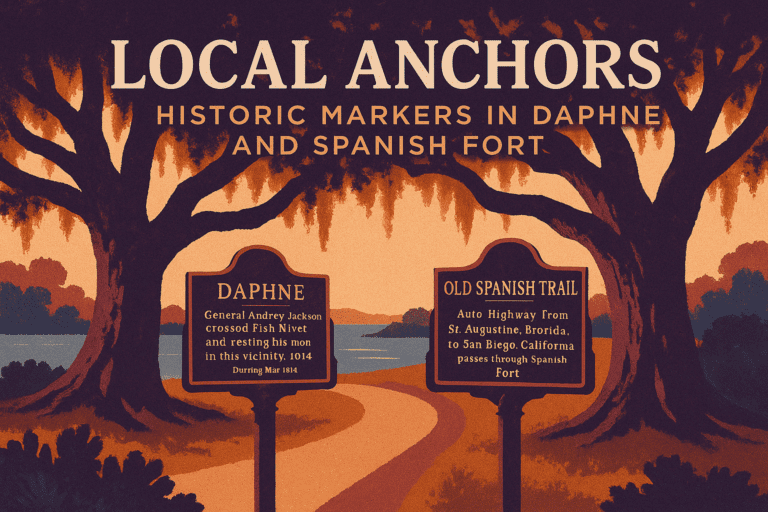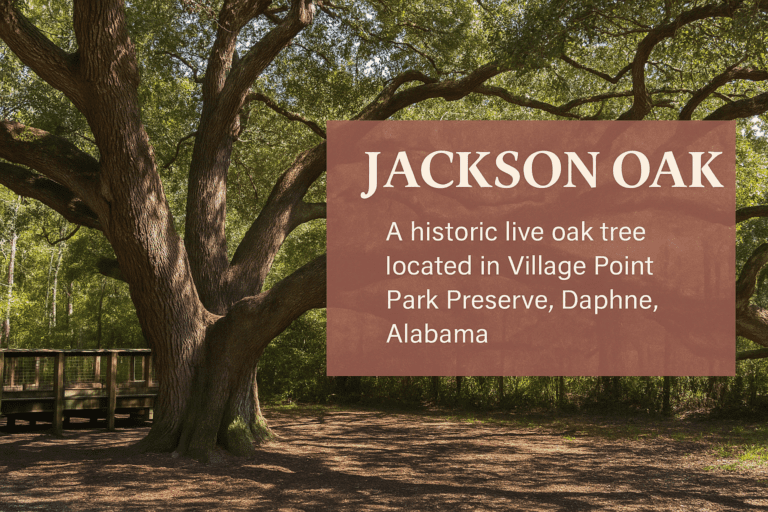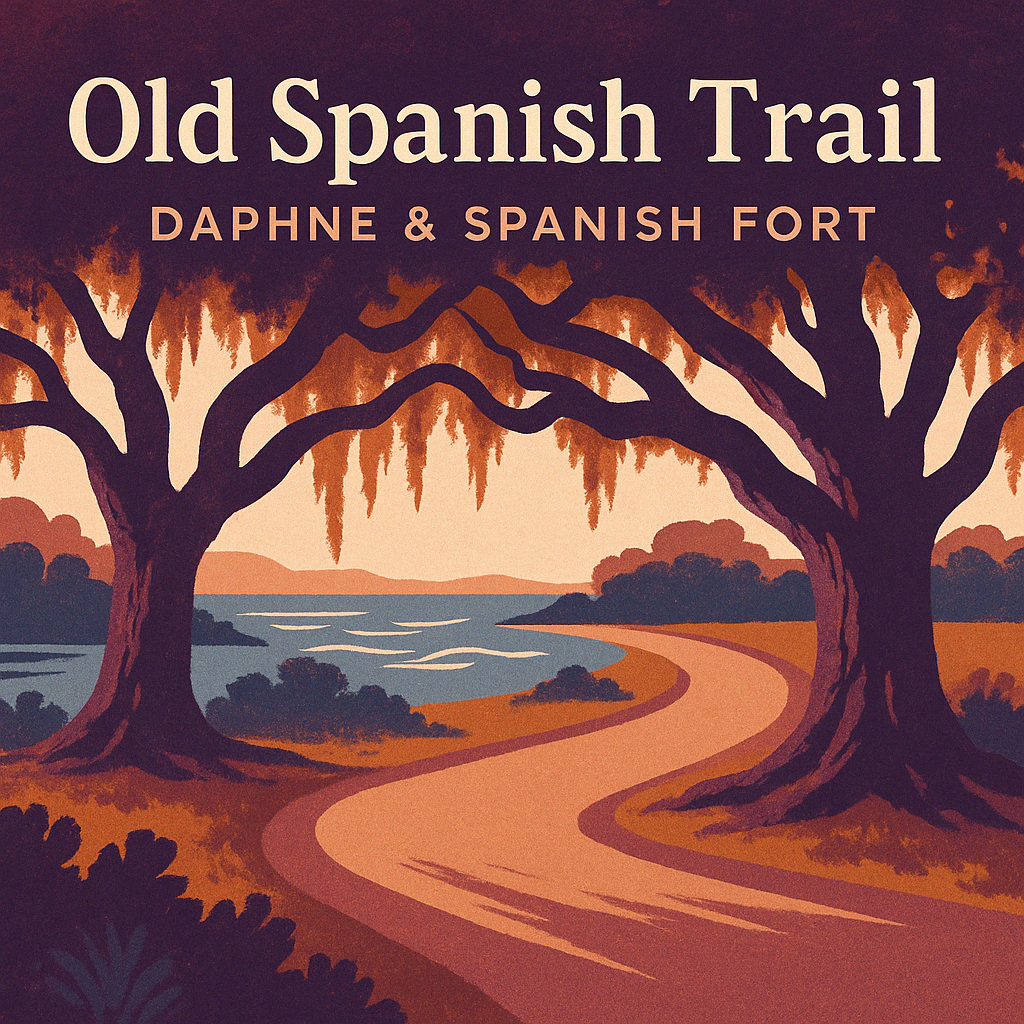Introduction: Where Past and Present Whisper Through the Pines
Along the winding roads of Daphne and Spanish Fort, you’ll find quiet reminders of a dream that once spanned from sea to shining sea. The Old Spanish Trail markers, modest and often overlooked, hold stories of adventure, determination, and connection—threads that bind our Eastern Shore to a grander American tapestry. These markers, scattered like timeworn breadcrumbs, guide us not just geographically, but emotionally, inviting us to step into a narrative far older than our modern highways.
This is the fourth gem in my “Hidden Gems of the Eastern Shore” series, and it’s a story that feels less like history and more like memory—like something your grandfather might’ve whispered over a porch swing at dusk. Let’s step into that story together.
The Old Spanish Trail: A Vision That Crossed a Continent
In the early 20th century, Americans were falling in love with the open road. The automobile wasn’t just a new way to travel—it was a symbol of freedom, possibility, and progress. Enter the Old Spanish Trail, or OST: a 2,750-mile auto highway envisioned as a grand route connecting St. Augustine, Florida, to San Diego, California.
The OST was more than a highway—it was a movement. Planners and local leaders promoted it as tracing the footsteps of Spanish explorers, evoking romantic notions of conquistadors and colonial pathways. Though no continuous Spanish route ever spanned from coast to coast, the OST captured the American imagination. Construction began in 1915, and by the 1920s, the trail had become a patchwork of paved and dirt roads weaving through eight southern states—including our beloved Alabama.
Here on the Eastern Shore, the trail followed the line of what we now know as U.S. Highway 90. It connected our coastal communities with the rest of the nation, putting Daphne and Spanish Fort on the map in more ways than one.
Markers were placed along the route to guide travelers, but also to anchor them—to offer a sense of place in a rapidly changing landscape. These granite and metal posts were tiny beacons of belonging, and today, they stand as quiet witnesses to a dream that once stretched from the Atlantic to the Pacific.
Local Anchors: Historic Markers in Daphne and Spanish Fort

In Daphne, you’ll find a particularly moving historical marker on Main Street, just south of Bayfront Park Drive. Erected by the Daphne-Spanish Fort Lions Club, this marker commemorates General Andrew Jackson and his troops, who camped in the area in 1814 during the War of 1812.
Imagine for a moment the sound of boots crunching underfoot, the flicker of lanterns, and the weight of a nation’s hope resting on weary shoulders. This land, now graced by oak trees and azaleas, once held the tension of an uncertain future. And Jackson’s men—ordinary and extraordinary all at once—found momentary rest here.
There are other markers too, some easier to find than others. Together, they create a constellation of memory: one that shines a light on our area’s involvement in not just the OST but centuries of military, colonial, and transportation history. From the Revolutionary War to the Civil War, and into the birth of America’s automobile age, the Eastern Shore has always been a threshold—a place where journeys begin and end.
A Living Symbol: The Jackson Oak in Daphne
And then, there’s the Jackson Oak.
Tucked within Village Point Park Preserve, this majestic live oak tree is one of the oldest and largest in Alabama. Its limbs stretch wide, like open arms welcoming the generations who’ve passed beneath it. Estimated to be more than 300 years old, the Jackson Oak has borne witness to indigenous councils, Spanish expeditions, French traders, and American pioneers.
But it’s the story of Andrew Jackson that gives the tree its name and mystique. According to local legend, Jackson addressed his troops from one of its limbs in 1814, boosting their morale before a critical push during the War of 1812. Whether myth or memory, the image endures: a general, a tree, and the hope of a young nation held in balance.
Today, the tree is lovingly protected, with observation platforms installed to preserve its roots. It’s more than a landmark—it’s a living archive, a gathering place, and a reminder that history is rooted not just in facts, but in feelings.

Why It Matters: Echoes of the Past, Lessons for Today
At first glance, the Old Spanish Trail markers might seem like quaint artifacts—curiosities tucked into the corners of our towns. But if we listen closely, they offer something deeper: a story about connection, about how roads can knit communities together across time and space.
They remind us that we’re not the first to travel these paths, nor will we be the last. Each marker, each tree, each story is part of a mosaic that gives meaning to where we live. They invite us to pause, to wonder, and to remember that the places we rush past were once destinations for someone else.
And perhaps that’s what makes these hidden gems shine so brightly—not their grandeur, but their quiet insistence that the past still matters. That the road we’re on didn’t begin with us. And that maybe, just maybe, it leads somewhere beautiful.
Summary Table: Old Spanish Trail Markers in Daphne & Spanish Fort
| Feature | Description |
|---|---|
| Location | Main Street in Daphne; sites throughout Spanish Fort |
| Historical Context | Part of the Old Spanish Trail auto highway (1920s); commemorates military and cultural history |
| Notable Marker | General Andrew Jackson’s 1814 encampment (War of 1812) |
| Broader Significance | Connects local history to national trade, military, and transportation developments |
| Modern Relevance | Heritage tourism, education, community identity, and preservation |
Plan Your Visit: How to Experience This Piece of Living History
Start your journey at Village Point Park in Daphne, where the Jackson Oak waits beneath a canopy of whispering leaves. Walk the trails, breathe in the scent of the bay, and let your imagination wander. Continue down Main Street and visit the commemorative marker just a short drive away.
In Spanish Fort, take time to visit additional historical sites and imagine what it must’ve been like when the OST was bustling with early automobiles and adventurers. Whether you’re a history buff, a weekend explorer, or someone who just loves a good story—this journey is yours to take.
Let’s Keep the Story Alive
If there’s one thing I’ve learned from living and working here on the Eastern Shore, it’s that our land remembers. It remembers every footstep, every milestone, every voice that ever said, “This is home.”
So let’s honor that. Let’s share these stories. Let’s preserve what’s precious—not because it’s old, but because it’s part of who we are.
Explore more Eastern Shore gems: youreasternshore.com/hidden-gems

